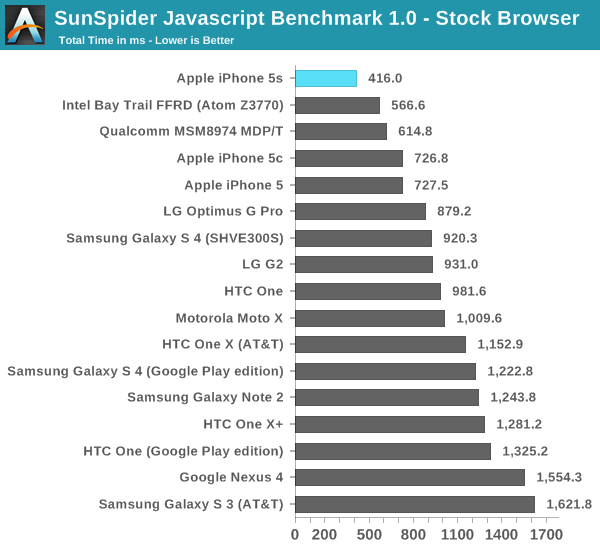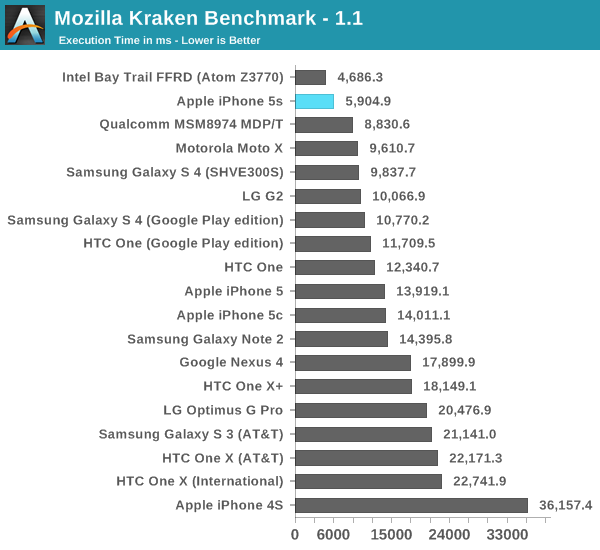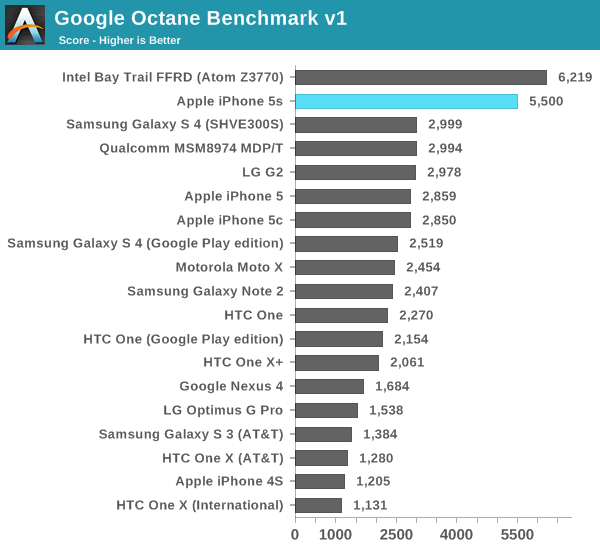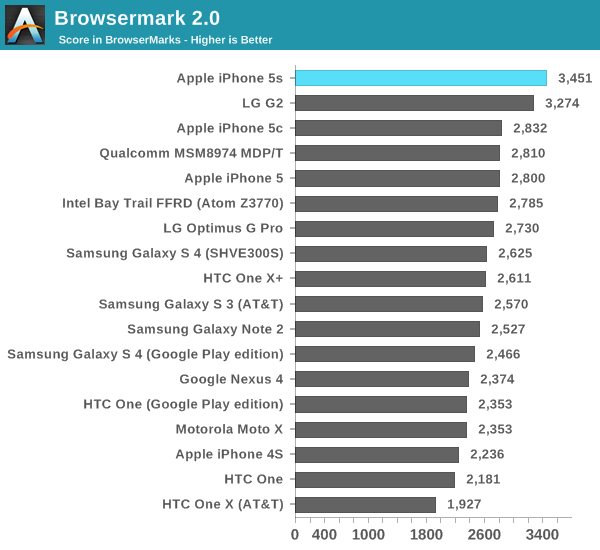The iPhone 5s Review
by Anand Lal Shimpi on September 17, 2013 9:01 PM EST- Posted in
- Smartphones
- Apple
- Mobile
- iPhone
- iPhone 5S
CPU Performance
For our cross-platform CPU performance tests we turn to the usual collection of Javascript and HTML5 based browser tests. Most of our comparison targets here are smartphones with two exceptions: Intel's Bay Trail FFRD and Qualcomm's MSM8974 Snapdragon 800 MDP/T. Both of those platforms are test tablets, leveraging higher TDP silicon in a tablet form factor. The gap between the TDP of Apple's A7 and those two SoCs isn't huge, but there is a gap. I only include those platforms as a reference point. As you're about to see, the work that Apple has put into the A7 makes the iPhone 5s performance competitive with both. In many cases the A7 delivers better performance than one or both of them. A truly competitive A7 here also gives an early indication of the baseline to expect from the next-generation iPad.
We start with SunSpider's latest iteration, measuring the performance of the browser's js engine as well as the underlying hardware. It's possible to get good performance gains by exploiting advantages in both hardware and software here. As of late SunSpider has turned into a bit of a serious optimization target for all browser and hardware vendors, but it can be a good measure of an improving memory subsystem assuming the software doesn't get in the way of the hardware.

Bay Trail's performance crown lasted all of a week, and even less than that if you count when we actually ran this benchmark. The dual-core A7 is now the fastest SoC we've tested under SunSpider, even outpacing Qualcomm's Snapdragon 800 and ARM's Cortex A15. Apple doesn't quite hit the 2x increase in CPU performance here, but it's very close at a 75% perf increase compared to the iPhone 5. Update: Intel responded with a Bay Trail run under IE11, which comes in at 329.6 ms.
Next up is Kraken, a heavier js benchmark designed to stress more forward looking algorithms. Once again we run the risk of the benchmark becoming an optimization target, but in the case of Kraken I haven't seen too much attention paid to it. I hope it continues to fly under the radar as I've liked it as a benchmark thus far.

The A7 falls second only to Intel's Atom Z3770. Although I haven't yet published these results, the 5s performs very similarly to an Atom Z3740 - a more modestly clocked Bay Trail SKU from Intel. Given the relatively low CPU frequency I'm not at all surprised that the A7 can't compete with the fastest Bay Trail but instead is better matched for a middle of the road SKU. Either way, A7's performance here is downright amazing. Once again there's a performance advantage over Snapdragon 800 and Cortex A15, both running at much higher peak frequencies (and likely higher power levels too, although that's speculation until we can tear down an S800 platform and a 5s to compare).
Compared to the iPhone 5, the 5s shows up at over 2.3x the speed of last year's flagship.
Next up is Google's Octane benchmark, yet another js test but this time really used as a design target for Google's own V8 js engine. Devices that can run Chrome tend to do the best here, potentially putting the 5s at a disadvantage.

Bay Trail takes the lead here once again, but again I expect the Z3740 to be a closer match for the A7 in the 5s at least (it remains to be seen how high the iPad 5 version of Cyclone will be clocked). The performance advantage over the iPhone 5 is a staggering 92%, and obviously there are big gains over all of the competing ARM based CPU architectures. Apple is benefitting slightly from Mobile Safari being a 64-bit binary, however I don't know if it's actually getting any benefit other than access to increased register space.
Our final browser test is arguably the most interesting. Rather than focusing on js code snippets, Browsermark 2.0 attempts to be a more holistic browser benchmark. The result is much less peaky performance and a better view at the sort of moderate gains you'd see in actual usage.

There's a fair amount of clustering around 2500 with very little differentiation between a lot of the devices. The unique standouts are the Snapdragon 800 based G2 from LG, and of course the iPhone 5s. Here we see the most modest example of the A7's performance superiority at roughly 25% better than the iPhone 5. Not to understate the performance of the iPhone 5s, but depending on workload you'll see a wide range of performance improvements.










464 Comments
View All Comments
Srinij - Thursday, September 19, 2013 - link
We need to include the Xiaomi Mi3 when its out, its touted as the fastest.koruki - Thursday, September 19, 2013 - link
Some test show its slower than a Samsung S3Shadowmaster625 - Thursday, September 19, 2013 - link
Who wants to bet that we will see a 10x increase in the number of robberies that involve limb amputation over the next 5 years?dugbug - Thursday, September 19, 2013 - link
you think its easier to remove a finger from someone than threatening them to unlock their phone (which could be done with any pascode-based phone). Really. Jesus.koruki - Thursday, September 19, 2013 - link
I'll take that bet."But Apple promises that its reader can sense beyond the top layer of a user’s skin, and includes a “liveness” test that prevents even a severed finger from being used to access a stolen phone."
http://www.forbes.com/sites/andygreenberg/2013/09/...
hasseb64 - Thursday, September 19, 2013 - link
MEH, Iphone 5x main problems:-Small battery
-Screen to narrow, need 5mm width
Fix this Apple and you maight get a new deal here
nitemareglitch - Thursday, September 19, 2013 - link
Still my number one site for deep dives on hardware. As always, you do NOT disappoint. I am going to upgrade now! You convinced me. I am sold.av13 - Thursday, September 19, 2013 - link
Anand, thanks a lot. Having worked with IBM iSeries systems since 2000 - RS65 III or iStar and now Power systems I was stunned when techies and investors alike were shrugging off Apple's transition to 64 bit. The fact that the A7 is RISC based and 64 bit its performance is going to show in single threaded and multi-threaded apps. It was even funny when some experts quipped that the 5s has to have at least 4 GB for the 64 bit to make sense. I was very encouraged that at least Apple decided on this roadmap.Great analysis by you - as usual - Yawn!
petersterncan - Thursday, September 19, 2013 - link
I would really like to see how these phones stack up against the Blackberry Z10, Q10 and Z30.Are you considering reviewing those any time soon?
ScottMinnerd - Thursday, September 19, 2013 - link
Please excuse my ignorance, but can someone please explain how a JS-based benchmark is any indication of the quality of a CPU?There's so much abstraction between JS code and the CPU registers that you might as well benchmark the performances of a Ferarri vs. a school bus while they're driving over mattresses and broken glass respectively. On the same browser on the same operating system on the same motherboard using the same RAM and the same bus architecture, yes, JS code could give a relevant basis for comparison of CPUs.
Also, does the included iOS browser have a multi-threaded JS engine? Does the Android's?
If one were to run 4 or 8 instances of the benchmark test simultaneously, how would each instance perform on each device having each CPU? Would the metric be higher on the 4+ core devices?
If Apple is leveraging a multithreaded JS engine, or a 64-bit optimized JS engine (or both), then the quality of the CPUs depends upon a given workload. The workload on a phone in the real world is rarely solely JS-based. Testing the performance of JS and then implying that the iPhone (or its CPU) is superior in general is not only misleading, but toadying.